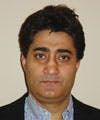Inside Track with Tarun Amla, Executive Vice President and Chief Technology Officer, Isola Group
TA: Among the cutting-edge applications are advanced driver-assist systems with radar applications for automobiles, such as adaptive cruise control. Other applications rising in the automotive space include collision avoidance, blind-spot detection, lane-departure warning, and stop-and-go systems. These devices now operate in the 24-GHz range, but they are increasing in frequency to the 76-to-81-GHz range. Dielectric materials also are being impacted by trends including higher-power-density power amplifiers (PAs), point-to-point microwave links, millimeter-wave applications, and GPS satellite antennas.
This file type includes high resolution graphics and schematics when applicable.
The characterization of dielectric properties at such high frequencies is a challenge. The use of gallium-nitride semiconductors in PAs is increasing the need for higher thermal conductivity and higher operating temperatures for dielectric materials. On the wireless-network side, heterogeneous networks are emerging as a solution for improving system capacity while enhancing network coverage and uniformity of coverage. In addition, small-cell deployment is driving the need for low-cost dielectrics while the deployment of 4G LTE systems raises the overall demand for telecommunications dielectric materials.
JJD: How is the increased interest in millimeter-wave technology impacting the dielectric-substrate industry?
TA: Millimeter-wave frequencies bring unique challenges. Microstrip designs at high frequencies are more prone to dispersion issues. Measurement methods and techniques are not established or standardized for measuring dielectric properties in the W-band region. There is an emerging need for non-polytetrafluoroethylene (PTFE) and non-thermoplastic-based substrates with dielectric properties that are similar to PTFE. Because of these challenges, Isola has been active in developing non-PTFE thermoset dielectrics, which display high glass transition temperatures and high thermal reliability while maintaining stability in dielectric properties over a higher range of temperatures and frequencies.
JJD: What RF/microwave markets are demanding the greatest volume of dielectric materials?
TA: The automotive market is creating significant demand with advanced driver-assist and safety systems. On the wireless infrastructure side, 4G LTE deployment is predominantly driving the need for volume.
JJD: How is the development of dielectric materials being affected by the RF/microwave integration trends leading to smaller RF ICs?
TA: The integration of both microwave and RF technology into ICs is affecting the usage of dielectric materials. Chip manufacturers are working to pack more and more functionality into the ICs, resulting in a reduced number of features on the dielectric. All of the attempts at integration are resulting in higher power density. Power density, in turn, leads to requirements for higher power dissipation, lower thermal resistance, and the need for stable dielectric properties to handle temperature, frequency, and humid environmental conditions.
JJD: As performance demands increase for RF/microwave devices, how are the tolerances for physical, temperature, and dielectric stability being affected?
TA: As mentioned earlier, requirements for the stability of dielectric properties (over temperature, humidity, and frequency)--along with requirements for improved dimensional stability--will continue to increase. Dimensional stability is a major issue with PTFE/ thermoplastic-based products. Poor dimensional stability can lead to low yields, causing manufacturing costs to go up significantly.
JJD: How are dielectric materials being developed to account for the high heat density of the latest RF/microwave devices, such as GaN PAs?
TA: GaN PAs are driving the need for increased power-handling requirements on dielectric materials. The power density for these devices is higher, as are the operating temperatures (which can be over 200° C). Both new dielectrics that have already been developed and those still under development are built around thermoset systems. Those systems boast very high glass transition temperatures (Tg) ranging from 200° to 230° C. Those high temperatures help to support higher device operating temperatures.
Higher thermal conductivity and lower loss are the other attributes targeted for improvement. Isola has been successful in the use of very-low-profile copper, which significantly reduces the thermal load due to reduced insertion loss. The key enabling technology is the use of a thermoset matrix. Because it has very good adhesion to metals, that matrix enables the use of copper with extremely smooth surfaces. Additionally, evaluations of nanotechnology solutions are being conducted to significantly improve thermal conductivity.
JJD: How are technological advancements enabling the placement of digital and RF/microwave electronics in decreasing footprints and separation?
TA: We are increasingly seeing hybrid boards that combine RF and digital technology. The increasing integration with RF chips makes it easier to combine the digital circuitry with the RF/microwave circuitry. Building boards that use different dielectrics and route digital waveforms and RF signals through specific layers enables a reduced footprint. These levels of integration pose a challenge, as conventional RF substrates like PTFE are not suitable for hybrid technology. The layer-count requirements are too high and bonding sheets are not available with PTFE materials. The newer substrates developed to solve these challenges, such as I-Tera MT, offer a range of thicknesses in bonding sheets (prepregs) and laminates.
JJD: How do the requirements for high-speed digital and RF/microwave dielectric substrates compare and contrast?
TA: A number of requirements have converged, such as the need for lower attenuation, stable dielectric constants, and low dissipation factors. The solution strategy for RF/microwave and digital substrates is still different for problems like crosstalk and noise reduction. Compared to RF/microwave boards, dielectric-material requirements on the high-speed digital side face emerging needs for isotropic substrates and much higher thermal reliability. In addition, high-speed digital-reliability needs are driven by extremely tight pitches on the components, leading to concerns about conductive anodic filament (CAF), delamination, drilling, plating, and other processes. These reliability requirements--coupled with sequential lamination designs requiring multiple laminations--are making high-speed-digital board manufacturing increasingly complex.
Yet integration efforts with high-speed-digital boards are minor compared to RF/microwave designs. Embedded systems are becoming increasingly common. Also, field-programmable gate arrays (FPGAs) are increasingly being used to perform error correction and other equalization or preconditioning. Skew due to the differences in the dielectric properties of resin and the required reinforcement is a major barrier toward achieving speeds beyond 25 Gb/s on a channel.
JJD: What is the biggest cost driver for dielectric substrates and how are the demands for lower costs being met?
TA: Most dielectrics in use today are based on PTFE or Butadiene resins, which intrinsically have very low glass transition temperatures. To build stiffness, ceramic fillers are added in high percentages. These fillers are highly abrasive, which leads to drilling issues. The drilling costs associated with these materials can be higher than the cost of the material itself.
Additional processing steps, such as plasma for hole-wall preparation, are expensive. Another drawback of these materials is poor dimensional stability, which translates into low yields. A recent analysis by Isola showed selling cost differing by close to a third between PTFE-based substrates and alternative thermoset systems.
JJD: What are some of the challenges and solutions when migrating dielectric materials?
TA: The dielectric properties of the two materials have to match. So parity between dielectric constants of two different suppliers is a requirement. This sometimes is difficult to achieve, as the X, Y, and Z dielectric constants are not the same for a majority of the products used in RF applications. This has not emerged as an issue on the digital side. But it is a challenge for RF/microwaves, as signal propagation is in the Z-direction with striplines in the transverse electromagnetic (TEM) mode.
All stripline methods extract the dielectric constant in the Z-direction. In fact, the dissipation factors also differ in the three directions. The microstrip designs that are predominant in RF applications transmit signals. Yet the propagation is not strictly in the Z direction and has X/Y components to it. This is why most RF designers start with a certain dielectric constant and tune their way to a design.
These factors may lead to the perception that changing substrates is an issue. Yet methods have been developed to characterize the dielectric constant and {dissipation factor (DF) in all three directions while using computational algorithms to arrive at the comparative dielectric constant. This means that the guesswork and multiple iterations are taken out of the selection of substrates. The algorithm uses finite-element methods to enable unit cells to extract the dielectric properties.
The ability to characterize these materials can extend to 125 GHz. Vector network analyzers, which go to different frequency ranges to provide precise measurement capability, also can be used to enhance material characterization. In addition, the split post-resonant cavity method, when coupled with the Bereskin and IPC stripline methods, helps to sketch the three-dimensional portrait of the product while aiding in simulations.
This file type includes high resolution graphics and schematics when applicable.
About the Author
Jean-Jacques DeLisle
Jean-Jacques graduated from the Rochester Institute of Technology, where he completed his Master of Science in Electrical Engineering. In his studies, Jean-Jacques focused on Control Systems Design, Mixed-Signal IC Design, and RF Design. His research focus was in smart-sensor platform design for RF connector applications for the telecommunications industry. During his research, Jean-Jacques developed a passion for the field of RF/microwaves and expanded his knowledge by doing R&D for the telecommunications industry.


